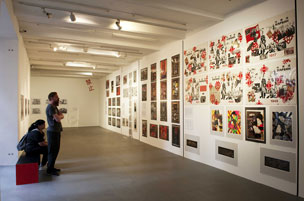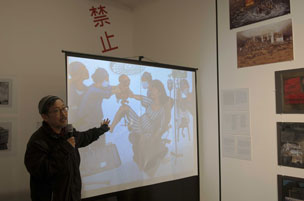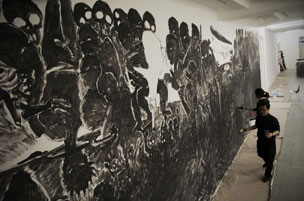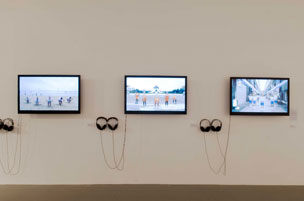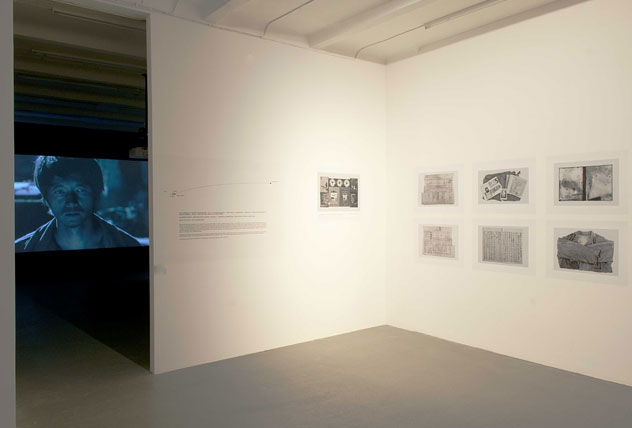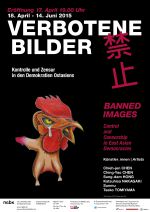D
Verbotene Bilder
(NGBK Berlin, 2015)
VERBOTENE BILDER Fotogalerie
Im November 2012 – kurz vor der Präsidentschaftswahl in Südkorea – hatte der Künstler Hong Sung-dam in der Ausstellung »Der Auszug der Seele aus dem Körper – Das Porträt der Yushin-Reform« im Museum für Frieden(Pyonghwa Bakmulkwan) in Seoul Arbeiten gezeigt, die eine kritische Haltung zur Kandidatin Park Geun-hye einnahmen (Goldene Zeit / Golden Time, 2012). Park Geun-hye, die heutige Präsidentin, ist die Tochter von Park Chung-hee, der nach einem Militärputsch Südkorea von 1961 bis 1979 mit diktatorischer Härte regierte. Wegen ihres offenen Bekenntnisses zur Politik ihres Vaters wird ihre Wahl von den progressiven und kritischen Kräften Südkoreas als gravierende Niederlage für die demokratische Entwicklung betrachtet. Während der Ausstellung wurde Hong Sung-dam tatsächlich von der Nationalen Wahlkommission wegen Verleumdung Park Geun-hyes verklagt, das Museum für Frieden polizeilich durchsucht, eine Spendenliste unter dem Vorwand der Veruntreuung von Geldern konfisziert und so das Museum für die Inhalte der Ausstellung »verwarnt«.
Die Ausstellung »Verbotene Bilder – Kontrolle und Zensur in den Demokratien Ostasiens« thematisiert jedoch nicht nur die Situation in Südkorea, sondern auch die der Nachbarländer Japan und Taiwan. Diese drei Länder werden von außen als vorbildliche Demokratien Ostasiens wahrgenommen und behandelt. Sie zählen zur »guten Seite«. Dabei wird außer Acht gelassen, dass in allen drei Ländern keine wirklich funktionierende Demokratie im westeuropäischen Sinne herrscht. Die kaum aufgearbeitete imperialistische Epoche der japanischen Politik und die unbewältigte Kolonisierung Taiwans und Koreas, die damit einherging, sowie die Nachwehen des Kalten Krieges sind wichtige Ursachen dafür, dass Meinungsfreiheit in allen drei Ländern von staatlicher Seite nicht als selbstverständlich akzeptiert wird. Eine der Folgen ist, dass die schematisch polarisierende Darstellung, die in Westeuropa und den USA üblich ist, schon in diesen Ländern selbst das öffentliche Bewusstsein bestimmt: Nord- und Südkorea werden ebenso wie China und Taiwan in einfachen Unterscheidungen gegenübergestellt: Sozialismus vs. Marktwirtschaft, Diktatur vs. Demokratie und Böse vs. Gut.
In der Ausstellung werden Werke von jeweils zwei Künstler_innen aus Japan, aus Südkorea und aus Taiwan gezeigt. Sie thematisieren kritisch die aktuelle Politik und rühren an die Tabus ihrer Länder, setzen sich für Meinungsfreiheit und Menschenrechte sowie die Aufarbeitung neuralgischer Themen der Vergangenheit ein und sie scheuen dabei die sozialen und politischen Konsequenzen ihrer Arbeit nicht.
VERBOTENE BILDER Fotogalerie
Im November 2012 – kurz vor der Präsidentschaftswahl in Südkorea – hatte der Künstler Hong Sung-dam in der Ausstellung »Der Auszug der Seele aus dem Körper – Das Porträt der Yushin-Reform« im Museum für Frieden(Pyonghwa Bakmulkwan) in Seoul Arbeiten gezeigt, die eine kritische Haltung zur Kandidatin Park Geun-hye einnahmen (Goldene Zeit / Golden Time, 2012). Park Geun-hye, die heutige Präsidentin, ist die Tochter von Park Chung-hee, der nach einem Militärputsch Südkorea von 1961 bis 1979 mit diktatorischer Härte regierte. Wegen ihres offenen Bekenntnisses zur Politik ihres Vaters wird ihre Wahl von den progressiven und kritischen Kräften Südkoreas als gravierende Niederlage für die demokratische Entwicklung betrachtet. Während der Ausstellung wurde Hong Sung-dam tatsächlich von der Nationalen Wahlkommission wegen Verleumdung Park Geun-hyes verklagt, das Museum für Frieden polizeilich durchsucht, eine Spendenliste unter dem Vorwand der Veruntreuung von Geldern konfisziert und so das Museum für die Inhalte der Ausstellung »verwarnt«.
Die Ausstellung »Verbotene Bilder – Kontrolle und Zensur in den Demokratien Ostasiens« thematisiert jedoch nicht nur die Situation in Südkorea, sondern auch die der Nachbarländer Japan und Taiwan. Diese drei Länder werden von außen als vorbildliche Demokratien Ostasiens wahrgenommen und behandelt. Sie zählen zur »guten Seite«. Dabei wird außer Acht gelassen, dass in allen drei Ländern keine wirklich funktionierende Demokratie im westeuropäischen Sinne herrscht. Die kaum aufgearbeitete imperialistische Epoche der japanischen Politik und die unbewältigte Kolonisierung Taiwans und Koreas, die damit einherging, sowie die Nachwehen des Kalten Krieges sind wichtige Ursachen dafür, dass Meinungsfreiheit in allen drei Ländern von staatlicher Seite nicht als selbstverständlich akzeptiert wird. Eine der Folgen ist, dass die schematisch polarisierende Darstellung, die in Westeuropa und den USA üblich ist, schon in diesen Ländern selbst das öffentliche Bewusstsein bestimmt: Nord- und Südkorea werden ebenso wie China und Taiwan in einfachen Unterscheidungen gegenübergestellt: Sozialismus vs. Marktwirtschaft, Diktatur vs. Demokratie und Böse vs. Gut.
In der Ausstellung werden Werke von jeweils zwei Künstler_innen aus Japan, aus Südkorea und aus Taiwan gezeigt. Sie thematisieren kritisch die aktuelle Politik und rühren an die Tabus ihrer Länder, setzen sich für Meinungsfreiheit und Menschenrechte sowie die Aufarbeitung neuralgischer Themen der Vergangenheit ein und sie scheuen dabei die sozialen und politischen Konsequenzen ihrer Arbeit nicht.
Tomiyama Taeko wird ihr ganzes Leben in Form einer Montage aus 50 Werken darstellen, die mit stets kritischem Blick auf das japanische Kaiserreich entstanden sind. Nakagaki Kasuhisa präsentiert seine jüngste Installation, die von der Kuratorin des Metropolitan Museum in Tokio zensiert wurde. Chen Chieh-jen und Chen Ching-Yao zeigen durch ihr künstlerisches Engagement die Themen auf, die in der taiwanesischen Gesellschaft lange Zeit tabuisiert wurden. Hong Sung-dam wurde in den 1980ern wegen seiner kritischen Haltung politisch verfolgt und gefoltert. Er ließ sich den Willen nicht brechen und gab den Kampf nie auf. Seine polemische Kritik an Park Geun-hye gilt inzwischen als so »furchtbar« und »schwer«, dass seine Bilder im doppelten Sinne des Wortes UNTRAGBAR geworden sind: In letzter Minute weigerte sich die beauftragte südkoreanische Kunstspedition, die Werke von Hong Sung-dam nach Deutschland zu transportieren, aus Angst, in den Ruf zu geraten, die Verbreitung verbotener Bilder zu unterstützen - vorauseilender Gehorsam funktioniert auf allen gesellschaftlichen Ebenen. Der heute südkoreanische Künstler Sunmu stammt aus Nordkorea und macht sich bei beiden Regimen unbeliebt, weil er nicht nur der nordkoreanischen, sondern auch der südkoreanischen Politik kritisch gegenübersteht. Auch seine Werke sind von der südkoreanischen Spedition nicht transportiert worden. Wir entschieden uns, die Bilder, die wir zeigen wollten, im Katalog abzudrucken. Bei der Ausstellung werden beide Künstler ihre Werke performativ re-präsentieren.
Wir möchten uns vor allem bei Prof. Dr. Vladimir Tikhonov, Kim Jong-gil, Prof. Dr. Rebecca Jennison, Arai Hiroyuki und Prof. Dr. Suh Sung für ihre inhaltsreichen Analysen zur komplexen Geschichte Ostasiens und zum Schaffen der Künstler_innen dieser Ausstellung bedanken. Ebenso danken wir Prof. Dr. Humphrey für seine unermüdliche Übersetzungsarbeit, Dr. Kai Lorenz und Kerstin Karge für das akribische Lektorat und Dong-Ha Choe für die wunderbare Gestaltung des Katalogs.
Berlin, den 31.03.2015
Han Nataly Jung-Hwa, Yajima Tsukasa, Yoo Jae-Hyun
Wir möchten uns vor allem bei Prof. Dr. Vladimir Tikhonov, Kim Jong-gil, Prof. Dr. Rebecca Jennison, Arai Hiroyuki und Prof. Dr. Suh Sung für ihre inhaltsreichen Analysen zur komplexen Geschichte Ostasiens und zum Schaffen der Künstler_innen dieser Ausstellung bedanken. Ebenso danken wir Prof. Dr. Humphrey für seine unermüdliche Übersetzungsarbeit, Dr. Kai Lorenz und Kerstin Karge für das akribische Lektorat und Dong-Ha Choe für die wunderbare Gestaltung des Katalogs.
Berlin, den 31.03.2015
Han Nataly Jung-Hwa, Yajima Tsukasa, Yoo Jae-Hyun
In November 2012, in the run-up to the South Korean presidential elections, the artist Hong Sung-dam put on display a painting entitled ›Golden Time‹ (2012) that manifested a critical stance towards the then candidate Park Geun-hye, the work being shown in the exhibition The Soul’s Departure from the Body – The Portrait of the Yushin Reform held in Seoul’s Museum of Peace (Pyonghwa Bakmulkwan). Park Geun-hye, now the country’s President, is the daughter of Park Chung-hee, who following a military putsch ruled South Korea with dictatorial severity from 1961 to 1979. On account of her frankly avowed belief in her father’s policies, progressive and critical forces in South Korea view her election as a grave defeat for the advance of democracy. In the course of the exhibition, Hong Sung-dam was in fact accused by the National Electoral Commission of defaming Park Geun-hye, the Museum of Peace was searched by police, a list of donations was confiscated under the pretext of embezzlement of funds, and the Museum was thus issued a ›warning‹ over the exhibition’s content.
The theme of the current exhibition Banned Images – Control and Censorship in East Asian Democracies, however, is not only the situation in South Korea but also that in the neighbouring countries of Japan and Taiwan. When viewed from outside, these three countries are seen and treated as exemplary East Asian democracies. They are in the ›good camp‹. This perception ignores, however, that none of the three countries has a genuinely functioning democracy in the western sense. The imperialist era in Japanese politics, with which the country has still barely come to terms, the concomitant colonization of Taiwan and Korea – this too an open sore – and the aftermath of the Cold War are all important reasons why in each of the three countries the state does not accept freedom of opinion as a matter of course. One consequence is that the rudimentary, dichotomized portrayals common in Western Europe and the United States also determine public consciousness in the three countries themselves. North and South Korea, just like China and Taiwan, are presented in terms of simple oppositions – socialism v. a free market economy, dictatorship v. democracy, evil v. good.
The current exhibition displays the works of two artists from each of the three countries, Japan, South Korea and Taiwan. The artists chosen cast a critical eye over present-day politics, trespass into taboo areas in their respective countries, take a stand on freedom of opinion and human rights, treat sensitive topics from the past and do not shy away from the social and political conclusions inherent in their work.
Tomiyama Taeko here presents her entire life in the form of a montage of 50 works created with an ever-critical eye on the Japanese Empire. Nakagaki Kasuhisa is exhibiting his latest installation, censored by the curator of the Metropolitan Museum in Tokyo. Chen Chieh-jen and Chen Ching-Yao use their critically engagé approach to point up topics that have long been taboo in Taiwanese society. Hong Sung-dam, politically persecuted and tortured in the 1980s on account of his critical stance, did not allow his will to be broken and never gave up the struggle. His polemical criticism of Park Geun-hye has come to be seen as so ›terrible‹ and ›grave‹ that his pictures have become INSUPPORTABLE or unbearable in the double sense of the word: at the last minute, the South Korean art forwarding company commissioned for the job refused to transport the works of Hong Sung-dam to Germany through fear of gaining the reputation of a disseminator of banned pictures – anticipatory obedience functions on all levels of society. Sunmu, now a South Korean artist, comes from North Korea and makes himself unpopular with both régimes because he takes a critical stance not only on North Korean but also on South Korean politics. His works were not transported by the South Korean forwarding agent either. We took the decision to reproduce in the present catalogue the pictures which we had intended to put on show. During the exhibition, the two artists will give a re-presentation of their works in performance style.
We would like to express our gratitude above all to Prof. Dr. Vladimir Tikhonov, to Kim Jong-gil, to Prof. Dr. Rebecca Jennison, to Arai Hiroyuki and to Prof. Dr. Suh Sung for their detailed analyses of East Asia’s complex history and of the oeuvres of the artists represented in the exhibition. Our thanks go equally to Prof. Dr. Richard Humphrey for his indefatigable translation work, to Dr. Kai Lorenz and Kerstin Karge for their copy-editing and proof-reading, and to Dong-Ha Choe for the design of the present catalogue.
Berlin, 31 March 2015
Han Nataly Jung-Hwa, Yajima Tsukasa, Yoo Jae-Hyun
U

